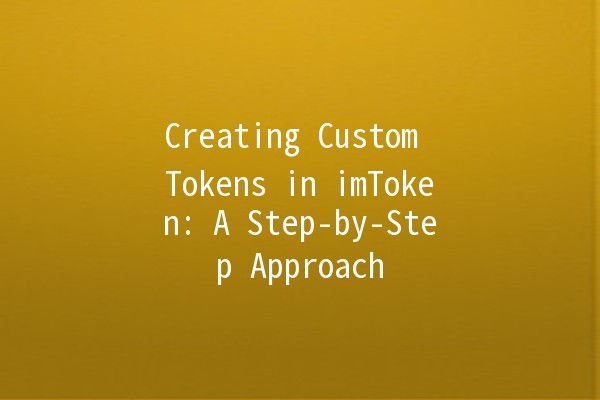Creating a custom token can be an enriching experience, whether for personal use, community engagement, or as part of a larger project. With the rise of decentralized finance (DeFi) and blockchain technology, imToken offers an accessible gateway for users to create and manage their tokens efficiently. This article provides a comprehensive look at the process and best practices surrounding custom token creation within the imToken platform.
ImToken is a multichain wallet that supports a wide range of cryptocurrencies and decentralized applications (dApps). Developed to be userfriendly, imToken allows users to manage their digital assets seamlessly. One of its standout features is the ability to create custom tokens, allowing users to tailor their financial ecosystem to their needs.
Before diving into the technical aspects, it's crucial to understand the foundation of what constitutes a token. Tokens are digital assets created on a blockchain, representing various forms of value, from currencies to commodities or even voting rights in decentralized organizations. In essence, creating a token involves deploying a smart contract, defining tokenomics (total supply, distribution, etc.), and ensuring it functions as intended within the ecosystem.

To begin with creating a custom token, you first need to ensure you have an imToken wallet set up.
Download and install the imToken app from the official website or app store.
Create a new wallet or import an existing one using your seed phrase or private key.
Once your wallet is set up, the next step is to find the token creation feature.
Open your imToken app and log in.
Navigate to the "Assets" tab.
Click on the "Create Token" option, usually found in the settings or tools menu.
This part of the process involves filling out necessary details about your token.
Name: Choose a unique name for your token.
Symbol: Create a catchy symbol that represents your token (like BTC for Bitcoin).
Decimals: Specify how divisible your token will be. For instance, a token with 18 decimals is commonly used.
Total Supply: Decide how many tokens you wish to create.
At this stage, the token is ready to be deployed on the blockchain.
Review your token specifications.
Confirm the creation process which may require a small amount of cryptocurrency (like ETH) for gas fees.
Submit the deployment transaction through your wallet.
Once your token is created, it’s essential to know how to manage and utilize it effectively.
Track your token on the imToken interface.
Share your token details with users or investors, ensuring they understand how to acquire or interact with it.
Consider listing your token on decentralized exchanges (DEX) to increase accessibility.
Creating a successful custom token goes beyond just deploying it. Here are five productivity tips to ensure your token embodies its intended purpose.
Before creating a token, conduct thorough research on existing tokens. Understand their functionalities and what makes them attractive.
Analyze how Uniswap’s governance token incentivizes user engagement and participation. Use these insights to structure your token’s value proposition.
Ensure your token serves a clear purpose. Is it for trading, governance, or rewards? A welldefined use case increases the token's credibility.
If you're creating a token for a gaming platform, outline how players earn and spend tokens within the game. This clarity can entice potential users.
Communication plays a vital role in fostering trust and loyalty. Engage with potential token holders via social media platforms or community forums.
Set up a Discord channel dedicated to discussions around the token. Encourage feedback and answer questions to build a robust community.
Once the token is live, monitor its performance through analytics tools. Adjust your strategies based on user interaction and market demand.
Use tools like Dune Analytics to track onchain activity related to your token. This data can inform marketing strategies and highlight areas for improvement.
Stay informed about legal considerations regarding token creation, as regulations can vary by region. Ensure your token complies with these regulations to avoid future legal issues.
If your token is classified as a security, comply with applicable securities regulations to mitigate risks.
Creating a token involves several costs, including gas fees for deploying the smart contract on the blockchain. Additionally, consider marketing and promotional expenses to raise awareness of your token.
To list your token, you typically need to provide liquidity by pairing it with a widely traded cryptocurrency such as ETH. Follow the DEX's submission process, which may include filling out forms and verifying your token details.
Generally, blockchain technology is immutable, meaning once a token is created, its specifications cannot be altered. Therefore, ensure all details are correct before deployment.
No, imToken is designed to make token creation accessible to users without programming experience. The app guides you through the process, making it userfriendly.
Utilize security best practices, such as testing your token's smart contract in a test environment before deployment. Engaging a thirdparty audit can further enhance security.
If your token does not gain traction, analyze why it’s not performing well. Engage the community for feedback, adjust marketing strategies, or consider pivoting the token’s use case.
Creating a custom token in imToken can be a straightforward process if approached correctly. With proper planning, research, and community engagement, your token can serve as a solid foundation for various projects and initiatives. As blockchain technology evolves, embracing these innovations will yield exciting opportunities for creators and users alike. Happy token crafting!